A quick look at 'fourth generation' biofuels

Major research organisations have found that over the long term, there is vast potential for sustainably produced bioenergy. Scientists working for the IEA's Bioenergy Task 40 put it at a maximum of around 1300 Exajoules by 2050 (current global fossil fuel use is around 380Ej per year). This biomass potential is explicitly based on a 'no deforestation' scenario and on the fact that all food, fiber and fodder needs of growing populations and livestock must be met first. After taking these requirements into account, the researchers find vast potential especially in Africa (320Ej) and Latin America (220Ej) (more here). In short, there will be no shortage of the primary natural resource - biomass - needed to make the transition towards a post-oil, low carbon future.
These optimistic scenarios do not take into account potential breakthroughs in biotechnology, such as the design of high yielding dedicated energy crops. But developments in this field are going very rapidly: high biomass crops, trees with increased carbon storage capacity, drought tolerant energy crops, grass species that beat the major problem of acidic soils, new plants with particular properties catering to a specific bioconversion process (e.g. low lignin trees, maize with embedded enzymes for rapid conversion) have already 'seen the light'.
The combination of such crops with advanced bioconversion techniques that allow for the capture and storage of carbon dioxide make it possible to yield a 'fourth generation' of ultra-clean carbon-negative fuels and energy.
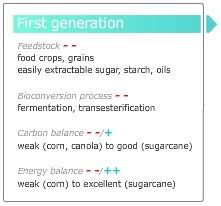 Let us have a look at how the different generations follow each other. First generation biofuels are known for their manifold problems: when made from grains such as corn or canola, they have negative impacts on food prices (this is not the case with sugarcane) and when relying on a crop like palm oil they threaten biodiversity; their carbon balance is bad in that they don't reduce the main greenhouse gas much or because conventional farming techniques (e.g. releasing nitrous oxide) offset the reduction (this, again isn't the case for sugarcane ethanol); their overall energy balance isn't that strong either (some have found that for corn ethanol it can even be negative; for sugarcane, the balance remains good). Finally, these first generation biofuels rely on relatively inefficient conversion technologies such as fermentation by conventional yeast strains or on transesterification by alkali catalysts.
Let us have a look at how the different generations follow each other. First generation biofuels are known for their manifold problems: when made from grains such as corn or canola, they have negative impacts on food prices (this is not the case with sugarcane) and when relying on a crop like palm oil they threaten biodiversity; their carbon balance is bad in that they don't reduce the main greenhouse gas much or because conventional farming techniques (e.g. releasing nitrous oxide) offset the reduction (this, again isn't the case for sugarcane ethanol); their overall energy balance isn't that strong either (some have found that for corn ethanol it can even be negative; for sugarcane, the balance remains good). Finally, these first generation biofuels rely on relatively inefficient conversion technologies such as fermentation by conventional yeast strains or on transesterification by alkali catalysts.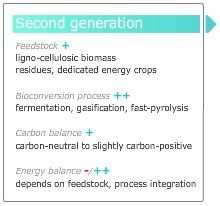 Second generation fuels involve a change at the bioconversion step and get rid of the apparent fuel versus food dilemma. Instead of only using easily extractible sugars, starches or oils as in the previous generation, these techniques allow for the use of all forms of lignocellulosic biomass. Grass species, trees, agricultural and industrial residues can all be converted via two main pathways: a biochemical and a thermochemical route. The first relies on dedicated enzymes and/or microorganisms that can break down cellulose and lignin to reach the sugars contained in the biomass. This pathway yields 'cellulosic ethanol'. Similar (engineered) microorganisms can also transform biomass into gaseous fuels like biogas and biohydrogen, via a process known as anaerobic digestion. Breakthroughs in synthetic biology may yield artificial biological organisms that perform these tasks in a highly efficient manner (earlier post).
Second generation fuels involve a change at the bioconversion step and get rid of the apparent fuel versus food dilemma. Instead of only using easily extractible sugars, starches or oils as in the previous generation, these techniques allow for the use of all forms of lignocellulosic biomass. Grass species, trees, agricultural and industrial residues can all be converted via two main pathways: a biochemical and a thermochemical route. The first relies on dedicated enzymes and/or microorganisms that can break down cellulose and lignin to reach the sugars contained in the biomass. This pathway yields 'cellulosic ethanol'. Similar (engineered) microorganisms can also transform biomass into gaseous fuels like biogas and biohydrogen, via a process known as anaerobic digestion. Breakthroughs in synthetic biology may yield artificial biological organisms that perform these tasks in a highly efficient manner (earlier post).The thermochemical route converts biomass via processes such as gasification and fast-pyrolysis. Gasification allows for the production of very clean synthetic biofuels, by liquefying the syngas via Fischer-Tropsch synthesis - combined, this pathway is known as 'biomass-to-liquids' (BTL). It remains relatively energy intensive, but the integration of processes promises increased efficiency. In fast-pyrolysis, biomass is rapidly heated (450-600°C) in the absence of air to yield a heavy fuel oil type liquid - bio-oil or pyrolysis oil - that can be further refined into a range of designer fuels or used as such. Alternatively, bio-oil and its residue (char) can be treated as a feedstock for BTL fuel production (previous post):
 energy :: sustainability :: climate change :: biomass :: bioenergy :: biofuels :: ethanol :: biodiesel :: energy crops :: plant biology :: biotechnology :: cellulosic ethanol :: gasification :: Fischer-Tropsch :: fast-pyrolysis :: biomass-to-liquids :: carbon capture and storage ::
energy :: sustainability :: climate change :: biomass :: bioenergy :: biofuels :: ethanol :: biodiesel :: energy crops :: plant biology :: biotechnology :: cellulosic ethanol :: gasification :: Fischer-Tropsch :: fast-pyrolysis :: biomass-to-liquids :: carbon capture and storage :: Synthetic biofuels and cellulosic ethanol have an excellent carbon balance and may reduce carbon dioxide emissions by up to 90% compared to petroleum based fuels. Moreover, they are ultra-clean and reduce emissions of the other major pollutants (NOx, SOx).
Combined, the potential of fuels based on biochemical and thermochemical biomass conversion is large. The World Energy Council recently estimated these fuels could replace approximately 40 percent of all petroleum based transport fuels, by 2050 (more here). The IEA Bioenergy Task 40 sees a far larger potential (up to 260 Ej by 2050, which would come down a replacement of all petro-fuels for transport (previous post).
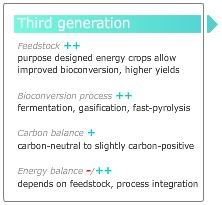 Whereas the second generation intervenes at the bioconversion step, the third generation of biofuels is based on advancements made at the source - the production of biomass. This generation takes advantage of new, specially engineered energy crops. There is significant progress to be made in this respect. Recent advancements in plant biology, the emergence of extremely efficient and fast breeding techniques (molecular breeding), the rapid advancements in the field of genomics, and classic design of transgenic crops promises to result in plants with properties that make them more suitable for conversion into bioproducts. Major research initiatives and organisations, such as the U.S. Dept. of Energy's Joint Genome Institute (JGI), are expected to deliver. Some of the world's leading biotech scientists, including Norman Bolaug, Craig Venter and Marc Van Montagu are involved.
Whereas the second generation intervenes at the bioconversion step, the third generation of biofuels is based on advancements made at the source - the production of biomass. This generation takes advantage of new, specially engineered energy crops. There is significant progress to be made in this respect. Recent advancements in plant biology, the emergence of extremely efficient and fast breeding techniques (molecular breeding), the rapid advancements in the field of genomics, and classic design of transgenic crops promises to result in plants with properties that make them more suitable for conversion into bioproducts. Major research initiatives and organisations, such as the U.S. Dept. of Energy's Joint Genome Institute (JGI), are expected to deliver. Some of the world's leading biotech scientists, including Norman Bolaug, Craig Venter and Marc Van Montagu are involved.Recent examples offer a glimpse of what we can expect in the near future. Just recently, scientists designed eucalyptus trees with a low lignin content, which allows for easier conversion into cellulosic ethanol (earlier post); likewise, one of the fathers of modern bio-engineering (now involved in the JGI) designed poplars with a lower lignin content (more here). Scientists at the Agricultural Research Service in the U.S. did the same for sorghum and have already made the cultivar available. It is seen as an ideal crop for cellulosic biofuels and co-production of feed (here).
Crop scientists are also succeeding in increasing the biomass yield of energy crops. So far they succeeded for sorghum (earlier post and here), with new major partnerships focusing on this same plant, seen by many as an ideal biofuel crop (more here). Crops with higher sugar content (sweet sorghum) that nonetheless thrive in more arid conditions have been developed and are being test-grown with ethanol production in mind (see here and here). Sticking to sorghum, scientists at Texas A&M University's Agricultural Experiment Station (TAES) are breeding a drought tolerant sorghum that may yield between 37 and 50 tons of dry biomass per hectare (15 to 20 tons per acre) (earlier post).
In a special case, researchers created a corn crop which already contains the enzymes needed to convert its biomass into fuels. This is an example of radical 'third generation' crops. The scientists relied on the emerging field of synthetic biology to discover the principles needed to allow for the design of the crop (earlier post). For his part, the most well known personality in the field of synthetic biology and genomics, Craig Venter, has partnered with the Asiatic Center for Genome Technology to sequence the genome of palm oil trees, which will lead to a crop more suitable for the biofuels industry (here). Norman Borlaug is sequencing cassava, a plant already used for efficient first generation biofuels, but which can be improved further by increasing its starch content (previous post).
Finally, in what must be seen as a breakthrough of major importance, scientists succeeded in overcoming the problem of acidic soils by designing a crop (sorghum) that can grow in such an environment. Half of the world's soils are acidic, the bulk of them in the tropics and sub-tropics. This crop and similar ones promise to make available a very large part of the world's land earlier deemed largely problematic for agriculture (more here).
This is just a short overview of the potential of new breeding, engineering and sequencing techniques that are being increasingly used to make designer crops. Note that not all of these are transgenic; molecular breeding techniques simply make it more easy to select robust crops and allows their release in a matter of months, instead of years.
These developments are being replicated in the design of food crops. If both sectors (food and fuel crops) continue to deliver breakthroughs, ever less land will be required to grow both food and energy. This may increase the initial estimations of the long term biomass potential (see above), because these projections did not take into account advancements in plant biology and biotechnology.
The use of such dedicated energy crops makes an impact on both its carbon and energy balance. With higher yields and easier bioconversion, less energy is needed to grow, harvest and transform a given amount of biomass.
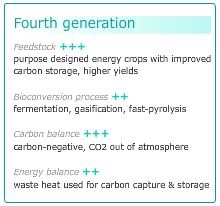 A particular development in plant biology must be mentioned, because it takes us straight to the 'fourth generation' of biofuels. Two teams of scientists recently announced they have succeeded in designing trees that store significantly more carbon dioxide than their ordinary counter parts. The feat has been achieved for eucalyptus (earlier post), a prime biomass crop suitable for cultivation in the tropics , and for Dahurian Larch (here), found in Northeastern Asia and Siberia.
A particular development in plant biology must be mentioned, because it takes us straight to the 'fourth generation' of biofuels. Two teams of scientists recently announced they have succeeded in designing trees that store significantly more carbon dioxide than their ordinary counter parts. The feat has been achieved for eucalyptus (earlier post), a prime biomass crop suitable for cultivation in the tropics , and for Dahurian Larch (here), found in Northeastern Asia and Siberia.In fourth generation production systems, biomass crops are seen as efficient 'carbon capturing' machines that take CO2 out of the atmosphere and lock it up in their branches, trunks and leaves. The carbon-rich biomass is then converted into fuel and gases by means of second generation techniques. Crucially, before, during or after the bioconversion process, the carbon dioxide is captured by utilizing so-called pre-combustion, oxyfuel or post-combustion processes. The greenhouse gas is then geosequestered - stored in depleted oil and gas fields, in unmineable coal seams or in saline aquifers, where it stays locked up for hundreds, possibly thousands of years.
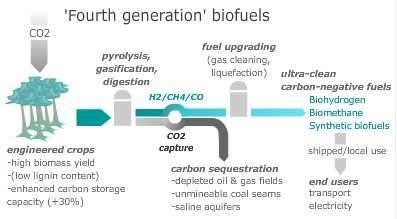
The resulting fuels and gases are not only renewable, they are also effectively carbon-negative. Only the utilization of biomass allows for the conception of carbon-negative energy; all other renewables (wind, solar, etc) are all carbon-neutral at best, carbon-positive in practise. Fourth generation biofuels instead take historic CO2 emissions out of the atmosphere. They are tools to clean up our dirty past.
According to scientists who looked at this concept of 'bio-energy with carbon storage' (BECS) within the context of a strategy to counter 'abrupt climate change', these systems, if applied on a global scale, can take us back to pre-industrial levels of atmospheric CO2. The concept would be more efficient than techniques that are limited to scrubbing CO2 out of the atmosphere without tackling the source of the problem: the combustion of fossil fuels. BECS intervenes at the source and replaces fossil fuels with renewable biomass; the systems scrub CO2 out of the atmosphere while delivering clean energy. As such, they are seen as one of the only low-risk geo-engineering methods that could help us tackle climate change without powering down our societies. (An overview of BECS systems can be found at the Abrupt Climate Change Strategy group, which has researched the basics: see their liberary, here).
The fact that fast-growing, high yielding trees are being designed that sequester more carbon dioxide, makes the promise of carbon-negative biofuels and bioenergy even more interesting.
Developments in 'carbon capture and storage' (CCS) technologies are being made in the coal industry. But when these techniques are applied to biomass, a new dimension opens up: that of decentralised production. In the case of coal, the application of CCS is tied to the location of coal plants and sequestration sites, or to the presence of mineable coal deposits and CO2 burial sites. In the first case, this means geosequestration will occur relatively close to inhabited places (cities). This presents risks.
Biomass on the contrary can be grown virtually anywhere. So CCS applied to biomass allows for an ideal scenario: the production of biomass close to a sequestration site that is far away from inhabited regions (many of these sites have already been identified). The carbon-negative fuel would be produced locally and then shipped to end users. Alternatively, biomass can be densified locally (pellets, bio-oil) and then transported to CCS facilities (either coal plants coupled to CCS where the biomass can be co-fired, or dedicated bioenergy plants). In any case, bioenergy with carbon storage allows for a decentralised approach, which is less likely the case for coal.
These fourth generation biofuels - fuel production coupled to CCS - are not a fantasy. The first step towards them is already being taken. Recently a the U.S. Department of Energy’s National Energy Technology Laboratory (DOE/NETL) and the U.S. Air Force (USAF) released a report which focused on the production of fuels made from combining the liquefaction of both coal and biomass, and then coupling the system to carbon sequestration technologies. It's a mouthful, but the concept comes down to: coal+biomass-to-liquids (CBTL) + carbon capture and storage (CCS), or CBTL+CCS (more here). The CBTL process consists of the production of so-called synthetic fuels, obtained from the gasification of feedstock, with the gas then liquefied via Fischer-Tropsch synthesis into an ultra-clean synthetic fuel. During the process, carbon dioxide is captured and then stored in geological formations such as depleted oil and gas fields or saline aquifers. The project is now being carried out by a team of Princeton researchers (earlier post). This is a first concrete project en route to pure biomass based carbon-negative synthetic fuels.
In conclusion, biofuel technologies are evolving rapidly. They have received some bad press because current production is dominated by inefficient first generation techniques that exert pressures on food markets and that present environmental problems. But a combination of plant biology, carbon capture techniques and novel bioconversion processes is set to open an era of fuels that will not only be abundant, highly energy efficient and clean, but that will be the single biggest weapon in the fight against climate change. Fourth generation carbon-negative biofuels are actually machines that take CO2 out of the atmosphere; they clean up our dirty past.
References:
Biopact: A closer look at the revolutionary coal+biomass-to-liquids with carbon storage project - September 13, 2007
Biopact: Scientists propose artificial trees to scrub CO2 out of the atmosphere - but the real thing could be smarter - October 04, 2007
Biopact: NETL and USAF release feasibility study for conceptual Coal+Biomass-to-Liquids facility - August 30, 2007
Biopact: Japanese scientists develop hybrid larch trees with 30% greater carbon sink capacity - October 03, 2007
Biopact: U.S. scientists develop drought tolerant sorghum for biofuels - May 21, 2007
Biopact: Ceres and TAES team up to develop high-biomass sorghum for next-generation biofuels - October 01, 2007
Biopact: Third generation biofuels: scientists patent corn variety with embedded cellulase enzymes - May 05, 2007
Biopact: Sequencing the cassava genome to boost biofuel potential - September 01, 2006
Biopact: Synthetic Genomics and Asiatic Centre for Genome Technology to sequence oil palm genome - July 11, 2007
Biopact: Major breakthrough: researchers engineer sorghum that beats aluminum toxicity - August 27, 2007
Biopact: Mapping sorghum's genome to create robust biomass crops - June 24, 2007
Biopact: Capiz region to trial high yield sweet sorghum for ethanol - March 30, 2007
Biopact: Sun Grant Initiative funds 17 bioenergy research projects - August 20, 2007
Biopact: Scientists release new low-lignin sorghums: ideal for biofuel and feed - September 10, 2007
Biopact: Celebrity spotting: Marc Van Montagu and GM energy crops - July 05, 2007
Biopact: Scientists develop low-lignin eucalyptus trees that store more CO2, provide more cellulose for biofuels - September 17, 2007
Biopact: World Energy Council: advanced biofuels can replace over 40% of petrofuels by 2050, most promising solution to reduce GHG emissions - October 08, 2007
Biopact: IEA report: bioenergy can meet 20 to 50% of world's future energy demand - September 12, 2007
Biopact: Report: synthetic biofuels (BtL) and bioenergy efficient, competitive and sustainable in Germany - September 22, 2007
 --------------
--------------
 Brasil Ecodiesel, the leading Brazilian biodiesel producer company, recorded an increase of 57.7% in sales in the third quarter of the current year, in comparison with the previous three months. Sales volume stood at 53,000 cubic metres from August until September, against 34,000 cubic metres of the biofuel between April and June. The company is also concluding negotiations to export between 1,000 to 2,000 tonnes of glycerine per month to the Asian market.
Brasil Ecodiesel, the leading Brazilian biodiesel producer company, recorded an increase of 57.7% in sales in the third quarter of the current year, in comparison with the previous three months. Sales volume stood at 53,000 cubic metres from August until September, against 34,000 cubic metres of the biofuel between April and June. The company is also concluding negotiations to export between 1,000 to 2,000 tonnes of glycerine per month to the Asian market.








0 Comments:
Post a Comment
Links to this post:
Create a Link
<< Home